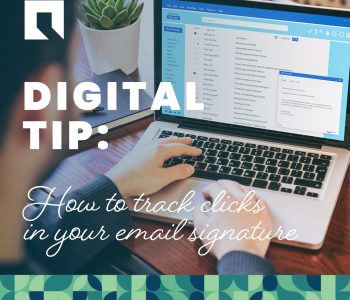
Typically, a professional email signature contains your name, job title, phone number, a link to your website, and maybe another piece of information such as a favorite quotation. While this contact information is useful for communicating with your clients, the link to your website can be a powerful tool for acquiring data analytics.
If you have Google Analytics installed, you can track clicks to your website from any employee’s email signature. There are lots of interesting insights you could pull from this data, for instance:
- How many people are clicking through email signatures then continuing to login, make a purchase, submit support tickets, request a quote or apply for a job? When looking at which employees are driving these actions, can we learn anything interesting?
- Are people clicking through email signatures then clicking off to social media links in our website footer? Maybe we should / should not add social links to our email signatures.
- Can we look at the user behavior from click throughs on salespeople’s signatures to learn what products might be trending?
Although different reports are more useful for different businesses, we’ll show you how to build a general report to see all pages that users view after clicking through from your email signature.
Tracking Email Signature Links
To help you get started, let’s walk through the process of tracking email signature links using Gmail and Google Analytics 4 (GA4), the replacement for Universal Analytics (UA).
- First, we’ll set up the tracking link. We’re going to do this with UTM (Urchin Tracking Module) parameters, a standard tracking device you can add to the end of links. Save your generated URL for later use.
- If you are not familiar with setting up a tracking link, Google’s Campaign URL Builder is a great tool.
- Tracking links does not change the destination to where the user is sent, but they do allow us to track their activity on our website. You can develop your own conventions for this, but we recommend setting the campaign to “email_sig”, the medium to “email”, and the “source” to the email sender’s name. Do remember it is important to keep these consistent.
- Next, find the “Signature” editor in your email platform. In Gmail, click on the “Settings” icon and select “See all settings” (make sure you are on the “General” tab). From here, you scroll down to the “Signature” section.
- Here, you can edit the link in your email signature. You want to leave the display text the same as your website but change the URL to point to the tracking link you created and copied in step one. Don’t forget to save your settings.
- Then, send out some emails to test click your signature link. Make sure that after you click on your signature, you see the tracking link in the browser URL bar.
- Now, let’s build some reports in GA4. You can either build custom reports in the “Explore” tab or use the default reports as shown below. These reports will not immediately provide very interesting data, but this will change after your tracking link gets more clicks and generates more data.
- Let’s set up a default report in GA4 to see this data by going to Reports >> Acquisition >> Traffic Acquisition. We like setting up the first dimension in the report table as “Session source / medium” and the second as “Session campaign” so we can see all of the UTM fields we set up in the tracking link.
- Next, add a filter to the report that corresponds with the convention you chose in step one.
Now, you have access to insights including how often each tracked email signature link was clicked and what actions users performed on your site!
Benefit of Tracking Email Signature Links
An interesting custom “Explore” report based on this data could show you all the pages that users view after clicking through from your email signature. Here’s how to do this:
- Set up a new blank “Explore” report.
- Add “Views” as a metric and dimensions for “Session source / medium, “Session campaign,” and Page path + query string.” Set up a filter so “Session campaign” exactly matches “email_sig” (or another convention you choose).
This allows you to see the pages viewed by people who clicked through from your signature!
Using Google Analytics to track clicks in email signature links can provide valuable insights into the effectiveness of your email signature links and the use of your website by your clients and prospects. These reports allow you to analyze and understand user engagement and help to enhance your marketing strategies.
Green Closet Creative offers media analysis services. Contact us today to learn more about how data informs marketing decisions.

